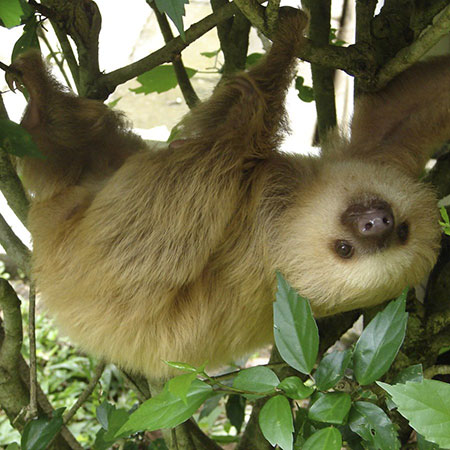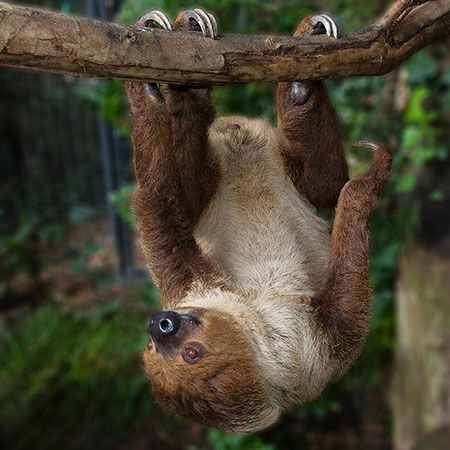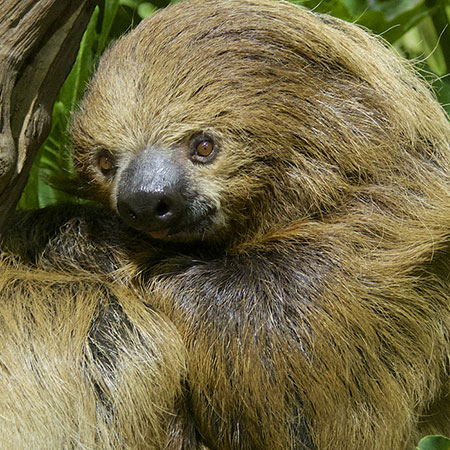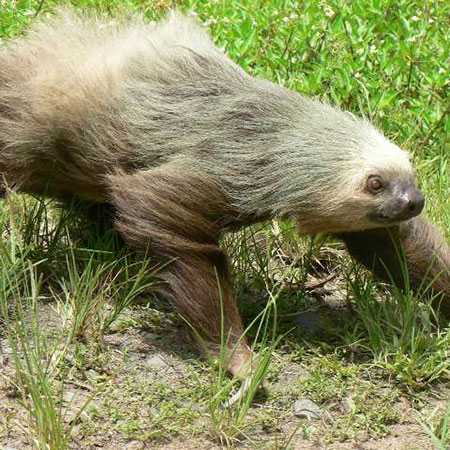General Information
The Linne’s two-toed sloth is a nocturnal mammal that is found in Northern South and Central America. They spend most of their time in the treetops. The sloth does everything upside down. They are slow-moving herbivores. They sleep about 15-18 hours per day and spend about 6 hours foraging for food.
Size
The Sloth’s weight ranges from 9 to 17 pounds, and 21-29 inches long.
Appearance
They have a short neck with 4 limbs that are pretty much equal in length, with long curved claws. They have an undercoat made up of short, fine hairs, and the overcoat is longer, thicker, and coarser. The sloth’s coat can turn green due to the growth of algae in moist conditions. They have large eyes and a flat, short head with a snub nose. The sloth’s fur is also home to moths, beetles, and ticks. Despite that fact, they do not have a bad odor.
Lifespan
The sloth lives 20 years in the wild but can live up to 30-40 years in captivity. The oldest known captive Sloth was 49 years old.
Habitat
The sloth is mostly a solitary animal, but sometimes females will stay in the
same tree. They live in the tropical tree canopies of Central and Northern South America. You will find them hanging upside down and only come down out of the tree to locate more food, defecate, or to change trees.
Diet
Sloths are mostly folivores, herbivores and require a balanced diet which should include fruits, vegetables, and leaves, and on occasion items like eggs or insects.
Reproduction
Females reach sexual maturity at about 3 years old, while males reach theirs at about age 4-5 years. Gestation is about 6 months, and they usually deliver one baby; twins are rare. Babies are around 12 ounces when they are born and cling to the mother’s belly for about 5 weeks at that time, they should be strong enough to move around on their own. The baby will stay with the mother for 9-12 months. Sloths breed once a year.
Other facts
Most of the time, the sloth is quiet but can hiss when in defense mode. When the sloth is in distress, it will communicate with a low-pitched bleat. The sloth has sharp canine teeth, and if threatened will grab with its claws and pull into its mouth and bite. When the baby sloth gets separated from its mom, it will communicate with a loud bleat that lasts about a minute. Sloths have an excellent sense of smell, and their ears can pick up low-frequency sounds. If a sloth feels threatened, it will use its teeth and claws to protect itself. Sloths have been known to survive severe wounds; they rarely become infected and seem to heal completely in about a month or less. Sloths are also excellent swimmers, they may drop from a tree and fall into a river and are able to swim to the shore. They cannot walk; they kind of drag themselves, but they usually only do this when moving to another tree.
Basic Care
Feeding
The sloth should be fed 10% of their body weight daily. It is also important to provide them with leaves, small branches, and flowers to forage. Their food should be cut into long, thin pieces so that they can grasp it with their long claws. Their teeth grow continuously and need to be worn down by plants. Sloths eat fruits, leaves, and some fresh green shoots. They are mostly herbivores, but sometimes will eat things like insects or bird eggs. They get water from their food and also lick up the dew from leaves. Zoos typically give their sloths apples, corn, kale, bananas, carrots, sweet potatoes, and Leaf Eater Biscuits. Provide fresh water daily and also by providing them with several sources at different levels throughout the enclosure.
Enclosure
You must provide your sloth with a climbing apparatus that has a variety of heights and widths. Provide them with a digging area at the base of their tree. Also, give them hammocks, a shelter for resting, and various platforms. You will also want to provide shelters for mom and baby.
Temperature
Sloths need high humidity of about 60-80% and a constant warm temperature of about 75-85 degrees. He/She will benefit from direct sunlight, but it is also important to provide shade to simulate leaf cover. You can also use broad-spectrum lighting. A light cycle should be set at 12 hours on and 12 hrs off to simulate the light cycle found in the tropics. Supply with a heat or cooling source as needed and secure to prevent injury to your sloth. It is important to remember that sloths cannot regulate their body temperature. If they get too warm or cold, their digestive system can shut down. Protect them from drafts.
Handling
Sloths, for the most part, do not like to cuddle. Holding and touching can cause them stress.
Toileting
The sloth has a slow metabolic system and urinates and defecates once a week. They will climb down and defecate at the base of the tree. They lose about 30% of their body weight after defecating.
Enrichment
You can provide a variety of enrichments for your sloth, change it up, and introduce new things to them to keep them mentally stimulated. You can use target training, which has some sort of item on a stick, and every time that your sloth touches it with his/her nose, give them a treat. This will help build trust and a bond, especially since they do not like to be touched. Scent enrichment is extremely important, especially because of their strong sense of smell. You can take a small plastic container, add some cinnamon, dill, etc, and your sloth will enjoy putting his/her head into the container and sniffing away. Introduce new foods, supply hanging feeders, and hide food in brown paper bags or boxes to encourage their foraging behaviors. They also enjoy nest boxes or crates, and add some bedding material. A large square basket is a good choice; your sloth will play with it and may even climb down into it and take a nap. Sloths like ball pits. Mirrors can also provide entertainment for sloths. Give them a scratching post, and provide them with some audio recording as well to stimulate their senses.
Requirements
For one or two sloths (two-toed or 3-toed) a cage measuring 4ft x 6ft by 8 ft high. For each additional sloth, you will need to increase the cage length by 25%. The enclosure floor should have a section for digging, and the enclosure should include several climbing apparatus (you can use tree limbs, artificial trees, etc. ), a den(s) for all the animals to share, basking areas, nest boxes, and a good source of enrichment. Make sure that all accommodations are compatible with your sloth. The boxes and shelters should be able to hold all the sloths at one time if they choose. Heating, cooling, and lighting to maintain appropriate temperatures, all with safety maintained to prevent injury to your sloth.




Basic Care
Feeding
A diet composed of a variety of protein sources such as tilapia, catfish, salmon, crustaceans and other protein sources is required. We also recommend a cat food with urinary tract protection. A healthy otter needs about 350 grams of food per day or up to 20% of its own body weight. However, the age, sex, pregnancy, lactation and the temperature all effect the amount of food needed by the otter.
As a baby you will need to order formula, Day One 30/50 from this site.
https://store.foxvalleynutrition.com/day-one-3050
Water
Also provide fresh water, keep it away from their swimming water. The bowl should be disinfected every day and shaped so that your otter cannot flip it over
Cleanliness
Clean the enclosure daily.
Enclosure
The area should large, stimulating with several hiding places to accommodate you otters.
Temperature
They prefer temps of 75-85 degrees F but can tolerate temps down to 52 degrees F. Their pool water temperature should be at 75-85 degrees F.
Exercise
The otter will get exercise by running, jumping and playing, swimming, climbing, etc..
Handling
Joeys need to be allowed to have uninterrupted sleep between their feedings. Frequent handling or noise ca stress them out and result in injury, serious illness and even death.
Toileting
They are messy and like to smear their feces with their hind legs and tail, They also scent mark with their urine. So daily cleaning of the enclosure is essential.
Enrichment
Otters love to play, they are very social. They are tactile and love playing with items that they can roam around in. We like to give them live fish, that get so excited. They also enjoy finding rocks, marbles, balls and any other objects that they can move around and take in the water with them. These are very inquisitive and agile animals. It is important to socialize them with both other otters, animals and humans.
They require specialized care and knowledge of this animal.
Requirements
In addition to the requirements listed above you will need to have an enclosure that for 1-2 otters that is 10 ft x 10 ft and 6 ft high. It must include devices that provide physical and mental stimulation that is compatible to your otter. Every device must be non-injurious. Examples are boxes, balls, pvc tubing, etc. Each enclosure must also have a shelter, den and nest boxes that can accommodate all the animals in the enclosure. For each additional animal you must increase the enclosure size by 25% of the original floor space
